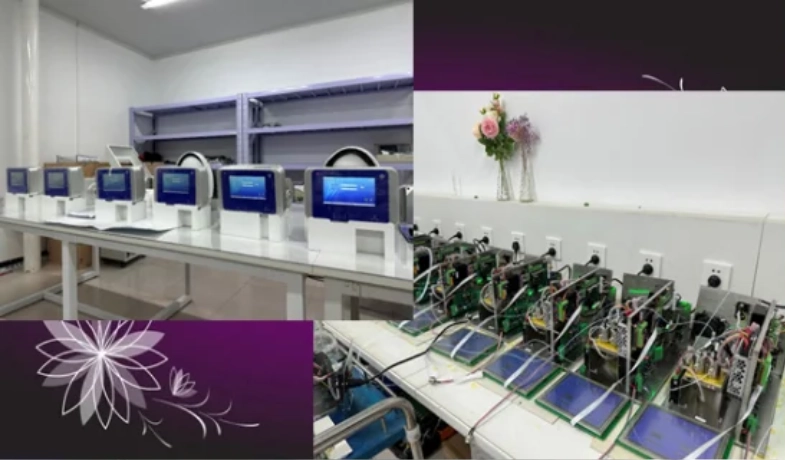Cómo funcionan los osmómetros de punto de congelación: Un análisis detallado
Cómo funcionan los osmómetros de punto de congelación: Un análisis detallado

Descubra el potencial del análisis de concentración de solutos. Desde el diagnóstico clínico hasta la investigación farmacéutica, descubra cómo funciona esta precisa técnica. Descubra por qué es vital para realizar pruebas de osmolalidad precisas.
Principios de la osmometría del punto de congelación
Conocer las propiedades de las soluciones exige métodos de medición exactos. La osmometría del punto de congelación destaca como un método crucial. Determina eficazmente la concentración de solutos en muestras biológicas y químicas.
El concepto de osmolalidad y su medición
La osmolalidad es un factor fundamental en los ámbitos científico, médico e industrial. Mide la concentración de partículas osmóticamente activas en una solución. Se expresa en osmoles por kilogramo de disolvente. Estas mediciones ofrecen una visión profunda del contenido de solutos. Se aplican a fluidos biológicos como el plasma sanguíneo, la orina y el líquido cefalorraquídeo. Al evaluar los niveles de solutos en muestras como las lágrimas o el suero humanos, contribuyen significativamente a múltiples campos. En el ámbito clínico, las pruebas de osmolalidad son esenciales. Ayudan a diagnosticar desequilibrios electrolíticos. También controlan el estado de hidratación.
El fenómeno de la depresión del punto de congelación
La depresión del punto de congelación se produce cuando los solutos se disuelven en un disolvente. Esto reduce su punto de congelación. Este efecto es fundamental en los osmómetros de punto de congelación. Cuando una solución se congela, los solutos interrumpen la formación de la red sólida. Esto requiere temperaturas más frías para la congelación. El grado de depresión del punto de congelación refleja directamente el número de partículas de soluto presentes.
Base científica de los osmómetros de punto de congelación
Los osmómetros de punto de congelación se basan en un principio clave. Los componentes osmóticamente activos de una solución reducen su punto de congelación. Estos aparatos miden la osmolalidad sobreenfriando una muestra por debajo de su punto de congelación. A continuación, inducen la cristalización. Se registra la temperatura a la que comienza la cristalización. Este es el punto de congelación. Este proceso preciso permite obtener datos exactos sobre la osmolalidad.
Componentes de un osmómetro de punto de congelación
Para proporcionar mediciones precisas de la osmolalidad, osmómetros de punto de congelación incluyen varios componentes fundamentales. Estos trabajan juntos para garantizar resultados fiables y coherentes.
Elementos estructurales clave
Un osmómetro de punto de congelación consta de elementos vitales. Están diseñados para realizar mediciones precisas y fiables. Colaboran a la perfección para evaluar la osmolalidad de forma eficiente.
Cámara de muestras y mecanismo de refrigeración
La cámara de muestras contiene la solución de ensayo. Mantiene las condiciones óptimas para la medición. Un mecanismo de refrigeración sobreenfría la muestra por debajo de su punto de congelación natural. Este enfriamiento controlado garantiza la uniformidad. También mejora la precisión en la detección de la depresión del punto de congelación.
Funciones de termistor y varilla agitadora
El termistor es un componente crucial. Detecta los cambios de temperatura con gran precisión durante la cristalización. Su sensibilidad garantiza resultados fiables. Capta incluso los cambios de temperatura más leves. Además, una varilla agitadora promueve una mezcla uniforme en la cámara de muestras. Esto garantiza una distribución uniforme de la temperatura en toda la solución.
Aplicaciones de los osmómetros de punto de congelación
Los precisos componentes de los osmómetros de punto de congelación permiten diversos usos. Estos abarcan el diagnóstico clínico, la investigación farmacéutica y la industria alimentaria.
Uso en laboratorios clínicos
Los osmómetros de punto de congelación se utilizan ampliamente en los laboratorios clínicos. Su eficacia y precisión los hacen ideales. Miden rutinariamente la osmolalidad del suero y la orina. Esto ayuda a evaluar el equilibrio hídrico. También ayuda a diagnosticar diversas afecciones. Algunos ejemplos son la evaluación de la función renal, la detección de la ingestión de alcohol tóxico y la monitorización de tratamientos con agentes osmóticos como el manitol.
Papel en la investigación farmacéutica
En la investigación farmacéutica, estos dispositivos desempeñan un papel importante. Apoyan la formulación de fármacos y el control de calidad. Los investigadores dependen de ellos para medir con precisión las concentraciones de principios activos en soluciones de fármacos. Su capacidad para manejar volúmenes de muestra minúsculos los hace perfectos para experimentos precisos con un mínimo de material.
Aplicación en procesos industriales
Más allá de los campos médico y farmacéutico, los osmómetros de punto de congelación tienen amplias aplicaciones industriales. Garantizan el control de calidad de productos como las bebidas isotónicas y las bebidas deportivas. Verifican los niveles de osmolalidad. Además, estos dispositivos se utilizan cada vez más para garantizar la calidad de diversos bienes de consumo. Su versatilidad se extiende a las industrias que manipulan polímeros o soluciones químicas. Las mediciones precisas de la concentración de solutos son fundamentales en estos sectores.
Flujo de trabajo operativo de los osmómetros de punto de congelación
La comprensión de estas aplicaciones pone de manifiesto la necesidad de explorar el flujo de trabajo paso a paso. Esto garantiza mediciones precisas con osmómetros de punto de congelación.
Preparación de la muestra y proceso de carga
La medición precisa de la osmolalidad comienza con una preparación cuidadosa de la muestra. Debe asegurarse de que la solución biológica o acuosa esté libre de partículas y contaminantes. Éstos podrían alterar el proceso de congelación. Las muestras, a menudo sólo microlitros, se cargan en la cámara de muestras. Las pipetas especializadas mantienen la precisión. Los osmómetros de punto de congelación destacan con soluciones biológicas diluidas, como suero u orina. Manejan muestras de pequeño tamaño de forma eficaz. Sus ventajas incluyen mediciones rápidas y rentables. Son los preferidos de la industria. Requieren volúmenes de muestra mínimos y se adaptan a soluciones diluidas.
Ciclo de refrigeración y medición
Una vez colocada la muestra en la cámara, comienza el mecanismo de enfriamiento. Éste sobreenfría la solución por debajo de su punto de congelación natural. Esto garantiza unas condiciones de cristalización controladas. Un termistor situado en el interior del osmómetro detecta los mínimos cambios de temperatura durante esta fase. La cristalización se desencadena, a menudo por una ligera perturbación mecánica. El termistor registra la temperatura de congelación. Esta temperatura se correlaciona directamente con la osmolalidad de la solución. La varilla agitadora garantiza una mezcla homogénea en la cámara. Esto favorece una distribución uniforme de la temperatura.
Interpretación y salida de datos
Después de medir la depresión del punto de congelación, puede analizar los datos. Así se determinan los valores de osmolalidad. Los osmómetros de punto de congelación modernos cuentan con sensores avanzados y sistemas automatizados. Estos mejoran la precisión y la velocidad. Algunos dispositivos completan las mediciones en segundos. Ofrecen una gran precisión y repetibilidad. Los resultados se muestran digitalmente. Muchos se integran sin problemas con los sistemas de gestión de la información de laboratorio (LIMS). Esto permite almacenar y analizar datos de forma eficaz.
Elección del proveedor adecuado de osmómetros de punto de congelación: MedIntegrity

Seleccionar un proveedor fiable de osmómetros de punto de congelación es vital. Garantiza una funcionalidad constante en laboratorios o entornos clínicos. Integridad médica destaca como proveedor de confianza. Tienen una gran experiencia en tecnología de osmometría. Su compromiso con la innovación y la superioridad les convierte en líderes en este campo. MedIntegrity se centra en la investigación y el desarrollo para garantizar que sus productos satisfagan las demandas cambiantes del sector. Se adhieren a estrictas normas de precisión y fiabilidad.
Características que hacen de MedIntegrity un proveedor de confianza
MedIntegrity ofrece funciones adaptadas a diversas necesidades operativas:
Ingeniería de precisión: Sus osmómetros ofrecen una gran precisión en todas las aplicaciones.
Interfaz fácil de usar: Los controles intuitivos simplifican el manejo. No es necesaria una formación exhaustiva.
Capacidad de integración: La compatibilidad con LIMS permite una transferencia de datos fluida.
Servicios integrales de apoyo: Proporcionan una asistencia sólida. Esto incluye la instalación y el mantenimiento. Se adapta a sus necesidades.
Estas cualidades hacen de MedIntegrity una opción ideal para invertir en tecnología de osmometría del punto de congelación.
Preguntas frecuentes sobre los osmómetros de punto de congelación
¿Cuál es el principio fundamental de la osmometría del punto de congelación?
La osmometría del punto de congelación se basa en un principio fundamental. Los componentes osmóticamente activos de una solución deprimen su punto de congelación. Midiendo esta depresión, se puede determinar con precisión la osmolalidad.
¿En qué se diferencian los osmómetros de punto de congelación de los de presión de vapor?
Ambos miden la osmolalidad, pero utilizan principios diferentes:
Osmómetros de punto de congelación: Medir la depresión del punto de congelación causada por solutos.
Osmómetros de presión de vapor: Confían en la depresión de la presión de vapor. Pueden tener problemas con componentes volátiles o muestras muy viscosas. Son menos comunes que los osmómetros de punto de congelación.
¿Pueden utilizarse los osmómetros de punto de congelación para aplicaciones no clínicas?
Sí, estos dispositivos son muy versátiles. Van más allá del ámbito clínico. Se utilizan cada vez más para garantizar la calidad de los bienes de consumo, como las bebidas isotónicas o deportivas. También sirven de apoyo a la investigación farmacéutica y a las operaciones industriales. Las mediciones precisas de la concentración de solutos son esenciales en estos campos.
Publicaciones relacionadas
-
El papel del analizador de carbono orgánico total en la medición del COT
25 de abril de 2025
-
Cómo un comprobador de integridad de guantes garantiza la seguridad en operaciones críticas
15 de abril de 2025
-
Consideraciones clave al utilizar un comprobador de integridad de bolsas para la detección de fugas
17 de abril de 2025
-
Exploración del papel del comprobador de integridad RTP en el diseño de aisladores asépticos
24 de abril de 2025
-
La importancia del comprobador de integridad de filtros para garantizar la seguridad de los productos
08 de abril de 2025









